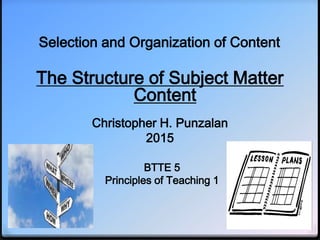
principlesofteaching-150914231414-lva1-app6891.pdf
- 1. Selection and Organization of Content The Structure of Subject Matter Content Christopher H. Punzalan 2015 BTTE 5 Principles of Teaching 1
- 3. Subject Matter matter presented for consideration in discussion, thought, or study the substance of a discussi on, book, writing, etc., as distinguished from its form or style.
- 5. The Structure of Subject Matter Content Cognitive Facts Concepts Principles Hypotheses Theories Laws Skill Thinking skills Manipulative skills Affective Realm of values and attitudes
- 7. Facts Fact is an idea or action that can be verified. Basic unit of cognitive subject matter content Example: names and dates of important activities population of the Philippines
- 8. Concepts Concept is a categorization of events, places, people, ideas. Example: Furniture -> chairs, tables, tables, beds, and desks. Swim -> breast stroke, crawl, butterfly
- 9. Principles the relationship(s) between and among facts and concepts. arrived at when similar research studies yield similar results time after time Example: Number of children in the family is related to the average scores on nationally standardized achievement tests for those children.
- 10. Hypotheses educated guesses about relationships (principles) Example: For lower division undergraduate students, study habits is a better predictor of success in a college course than is a measure of intelligence or reading comprehension.
- 11. Theories refer to a set of facts, concepts and principles that describe possible underlying unobservable mechanisms that regulate human learning, development, and behavior. explains why these principles are true. Example: Piaget’s theory on cognitive development
- 12. Laws firmly established, thoroughly tested principle or theory Example: Thorndike’s law of effect Law on the conservation of matter and energy Law of supply and demand Law of gravity
- 13. SKILLS Manipulative skills Thinking Skills Divergent thinking Convergent thinking Problem solving Metaphoric thinking Critical thinking Creative thinking
- 14. Manipulative Skills for courses / subjects that are dominantly skill –oriented Computer Home Economics and Technology Physical Education Music The learning of these manipulative skills begin with simple manipulation and ends up in expert and precise manipulation.
- 15. Thinking Skills the skills beyond recall and comprehension They are skills concerned with the application of what was learned, (in problem-solving or in real life) evaluation, critical and creative thinking and synthesis. Thinking Skills Divergent thinking Convergent thinking Problem solving Metaphoric thinking Critical thinking Creative thinking
- 16. Divergent Thinking Includes the following and its characteristics Fluent thinking generation of lots of ideas thought flow is rapid thinking of the of the most possible ideas Flexible thinking variety of thoughts in the kinds of ideas generated different ideas from those usually presented Original thinking differs from what’s gone before thought production is away from the obvious and is different from the norm Elaborative thinking embellishes on previous ideas or plans (Torres, 1994) Uses prior knowledge to expand and add upon things and ideas
- 17. Convergent Thinking It is narrowing down from many possible thoughts to end up on a single best thought or an answer to a problem.
- 18. Problem Solving Made easier when the problem is well-defined. “The proper definition of a problem is already half the solution” Can be solved by using : algorithm – following specific, step by step instructions heuristic strategy – general problem solving strategy, for a solution - experience based techniques
- 19. Effective Problem Solving Strategies Provide worked-out examples of algorithms being applied Help students understand why particular algorithms are relevant and effective in certain situations When a student’s application of algorithm yields an incorrect answer, look closely at the specific steps the student has taken until the trouble spot is located.
- 20. For teaching heuristics: Give students practice in defining ill-defined problems Teach heuristics that students can use where no algorithms apply Examples of real-life heuristic that people use as a way to solve a problem or to learn something: Educated guess Common sense Availability heuristic Working backward Familiarity heuristic
- 21. For teaching both algorithm and heuristics: Teach problem-solving strategies within the context of specific subject areas (not as a topic separate from academic content) Provide scaffolding for difficult problems Have students solve problems in small groups
- 22. Metaphoric Thinking Also called “Analogic thinking” Uses analogic thinking A figure of speech where a word is used in a manner different from its ordinary designation to suggest or imply a parallelism or similarity Example: Teaching is lighting a candle. The learner’s mind is a “blank slate”.
- 23. Critical Thinking Involves evaluating information or arguments in terms of their accuracy and worth. (Beyer, 1985) It takes a variety of forms Verbal reasoning Argumentative analysis Hypothesis testing Decision making
- 24. Creative Thinking Involves producing something that is both original and worthwhile For Creative thinking we must develop: Awareness Curiosity Imagination Fluency Flexibility Originality Elaboration Perseverance
- 25. AFFECTIVE Three-level approach to teaching Values Cognitive Skill
- 26. Values and Attitudes Values can be taught They are both taught and caught. Values have : Cognitive dimension Affective dimension Behavioral dimension Affective component is concerned with values and attitudes. When we teach values, we connect facts, skills and concepts to the life of students.
- 27. How can we teach values? Deutero-learning : Your student learns by being exposed to the situation, acquainting himself with a setting following models pursuing inspirations copying behavior “YOUR CRITICAL ROLE AS MODELS IN AND OUTSIDE THE CLASSROOM CANNOT BE OVEREMPHASIZED” Positive reinforcing good behavior Teaching cognitive component of values in the classroom
- 29. Reference Ormrod, 2000 Jeanne Ellis Ormrod, Ph.D. Professor of Psychological Sciences McKee Hall jormrod@comcast.net Areas of Specialization: Learning and cognition Study strategies Pedagogy